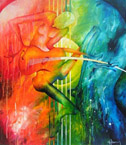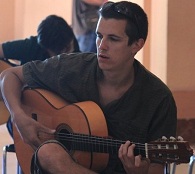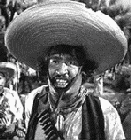Welcome to one of the most active flamenco sites on the Internet. Guests can read most posts but if you want to participate click here to register.
This site is dedicated to the memory of Paco de Lucía, Ron Mitchell, Guy Williams, Linda Elvira, Philip John Lee, Craig Eros, Ben Woods, David Serva and Tom Blackshear who went ahead of us.
We receive 12,200 visitors a month from 200 countries and 1.7 million page impressions a year. To advertise on this site please contact us.
|

|
|
How often to use capos?
|
You are logged in as Guest
|
|
Users viewing this topic: none
|
|
Login  | |
|

   
Ricardo
Posts: 14887
Joined: Dec. 14 2004
From: Washington DC

|
 RE: How often to use capos? (in reply to trivium91) RE: How often to use capos? (in reply to trivium91)
|
|
|
My problem is that I learned my entire neck as a teenager so when I play a piece in say A major down low with capo at 1, I can ignore the capo on a guitar with no dots. However, when I move up to high positions my brain transposes immediately to the key of Bb where I see Bb’s and Eb’s all over the place. Thinking in two keys can be problematic if you have to position the capo to a place you never played before.
The other reason for capo is not for ease of stretching or something, rather, it is for cleaning up the sound. The guitar might get muddy playing siguiriya or buleria etc, anything por medio. You want the chords to brighten up sonically and you could play barre chords in B or C# phrygian, but simply putting the capo up at 2-4 position suddenly makes the guitar sparkle, at the expense of losing low bass notes. Having recently gotten into Renaissance Vihuela tabs, I realize the instruments used to be pitched up compared to a modern guitar such that to blend with the voice properly (a majority of the music is based on what we would call “Flemish vocal polyphony intabulations”), the concept of a “key” with open chords is analogous to cante accompaniment with capo positions at 3 or 5 in some cases. Based on comparing to original vocal music scores they might have worked with and the chosen keys, I feel a guy like Mudarra must have had a pitched vihuela at low note F#, Bermudo used an example low note A, Fuenllana at G, and Vinegas used a special notation system where he felt the low E (exactly like modern guitar) would cover all tessitura of vocal music.
It is as if the capo was invented specifically to eliminate the need for having as many different pitched instruments such that we could relate specific key sounds (tonalities) to blend with vocal music. And in case you did not know, Flemish means “flamenco” in Spanish.
_____________________________
CD's and transcriptions available here:
www.ricardomarlow.com
|
|
|
|
REPORT THIS POST AS INAPPROPRIATE |
Date Apr. 30 2024 11:59:18
 |
|

   
trivium91
Posts: 219
Joined: Jan. 24 2022

|
 RE: How often to use capos? (in reply to Ricardo) RE: How often to use capos? (in reply to Ricardo)
|
|
|
quote:
ORIGINAL: Ricardo
My problem is that I learned my entire neck as a teenager so when I play a piece in say A major down low with capo at 1, I can ignore the capo on a guitar with no dots. However, when I move up to high positions my brain transposes immediately to the key of Bb where I see Bb’s and Eb’s all over the place. Thinking in two keys can be problematic if you have to position the capo to a place you never played before.
The other reason for capo is not for ease of stretching or something, rather, it is for cleaning up the sound. The guitar might get muddy playing siguiriya or buleria etc, anything por medio. You want the chords to brighten up sonically and you could play barre chords in B or C# phrygian, but simply putting the capo up at 2-4 position suddenly makes the guitar sparkle, at the expense of losing low bass notes. Having recently gotten into Renaissance Vihuela tabs, I realize the instruments used to be pitched up compared to a modern guitar such that to blend with the voice properly (a majority of the music is based on what we would call “Flemish vocal polyphony intabulations”), the concept of a “key” with open chords is analogous to cante accompaniment with capo positions at 3 or 5 in some cases. Based on comparing to original vocal music scores they might have worked with and the chosen keys, I feel a guy like Mudarra must have had a pitched vihuela at low note F#, Bermudo used an example low note A, Fuenllana at G, and Vinegas used a special notation system where he felt the low E (exactly like modern guitar) would cover all tessitura of vocal music.
It is as if the capo was invented specifically to eliminate the need for having as many different pitched instruments such that we could relate specific key sounds (tonalities) to blend with vocal music. And in case you did not know, Flemish means “flamenco” in Spanish.
That makes alot of sense. I guess Solea will mostly be played without one as its slower than say a bulerias, plus the fuller sound will complement solea but not so much bulerias.
|
|
|
|
REPORT THIS POST AS INAPPROPRIATE |
Date Apr. 30 2024 15:11:44
 |
|

   
Ricardo
Posts: 14887
Joined: Dec. 14 2004
From: Washington DC

|
 RE: How often to use capos? (in reply to trivium91) RE: How often to use capos? (in reply to trivium91)
|
|
|
quote:
That makes alot of sense. I guess Solea will mostly be played without one as its slower than say a bulerias, plus the fuller sound will complement solea but not so much bulerias.
As mentioned there are no special tendencies. I will admit that capo 1 lowers the action the nut adds, so some players favor that at minimum for challenging solos. Also the guitar sometimes has annoying strong frequencies emphasized by harmonics and wood resonances (the back apparently cuz I can’t hear that F# claimed for the soundboard). A capo at 1 might just kill those overtones and make the guitar sound more clear overall. For cante it is more common to see Soleá ABOVE 5 than not. This is because of the tessitura (melodic range) of the melodies. Only the Triana/Apolá cantes, that require higher sung pitches, will use the lower capo, and these are sung much less frequently.
Now, an interesting point about high capos for cante, such as mentioned Paquera singing solea etc at 7 por medio. While it is an interesting sound, and good players make it super powerful despite the lack of low bass notes, any musician minded person will ask, “why not just lose the capo and play por Arriba?”….the absolute key is the same, E phrygian. So why not go for a fuller sound of low position open chords vs the ukulele sounding 7 por medio? Well, before checking out this vihuela stuff I never had an answer for that, other than taste or “it sounds cool for some reason”. And of course a flamenco artist like Parrilla or Cepero is using taste and intuition here, but a possible Renaissance practice explanation is super interesting to me.
Back in the Renaissance, the vihuela guys were not just making up chords to accompany sung melodies, they were instead looking to arrange the stacked vocal lines literally. So they take the bass part and put it on the bass strings, the tenor in the middle strings, and the alto or soprano on the treble strings. Chord “voicings” were literally vocal PARTS. (Imagine the strings of a flamenco guitar are little singers that sing along with the cantaor, rather than shifting block-chords. Rasgueado is just a way of sustaining the voices that otherwise die too quick compared to the cantaor.) So when there would be a piece where the main melody is to remain sung by a person and the vihuela will be doing all the counter voices, they chose a key that best represents where the sung part needs to sit in the pitch spectrum. (Sometimes the sung voice is the highest in the spectrum, but NOT always). So that means a melody by Paquera would be very high like a soprano voice, and the guitar chords down in por Arriba open, would be way too low for a melody like that. 7 Por medio sounding much higher and closer in the pitch spectrum to the main voice works better.
The counter voice needs to be heard BELOW, so when we hear Parrilla’s top string ringing at 7, it is a B note which complements the melody that might go up to E-D-C-B etc., above that. Conversely a male baritone voice sings a melody that is crossing into the tenor vocal part range, allowing the por Arriba higher string pitches to ring as “discant” or counter high voices ABOVE the main melody. This concept of the flamenco guitar chordal voicings complementing the cante, I feel, is a relic of the Renaissance vocal “Flemish” style polyphony. The tradition of “por Arriba” is better suiting sung melodies that are by design, based on church modes 1,3,5,7, where as “por medio” is better suited to the “hypo” or “plagal” modes 2,4,6,8, which is a huge generalization, however based on the practice of setting melodies within some specific range. In flamenco the roles swap if you have melody sung by a female vs a male, and because they are not “trained” singers in the classical sense, there is overlap which the capo facilitates.
_____________________________
CD's and transcriptions available here:
www.ricardomarlow.com
|
|
|
|
REPORT THIS POST AS INAPPROPRIATE |
Date Apr. 30 2024 23:58:49
 |
|
 New Messages New Messages |
 No New Messages No New Messages |
 Hot Topic w/ New Messages Hot Topic w/ New Messages |
 Hot Topic w/o New Messages Hot Topic w/o New Messages |
 Locked w/ New Messages Locked w/ New Messages |
 Locked w/o New Messages Locked w/o New Messages |
|
 Post New Thread
Post New Thread
 Reply to Message
Reply to Message
 Post New Poll
Post New Poll
 Submit Vote
Submit Vote
 Delete My Own Post
Delete My Own Post
 Delete My Own Thread
Delete My Own Thread
 Rate Posts
Rate Posts
|
|
|
Forum Software powered by ASP Playground Advanced Edition 2.0.5
Copyright © 2000 - 2003 ASPPlayground.NET |
0.09375 secs.
|


 Printable Version
Printable Version










 New Messages
New Messages No New Messages
No New Messages Hot Topic w/ New Messages
Hot Topic w/ New Messages Hot Topic w/o New Messages
Hot Topic w/o New Messages Locked w/ New Messages
Locked w/ New Messages Locked w/o New Messages
Locked w/o New Messages Post New Thread
Post New Thread